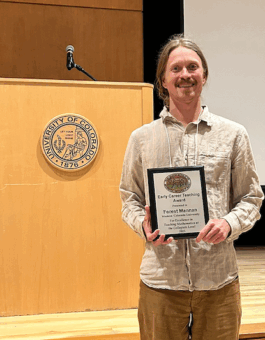Western professor, students show us we can do more with less
We get an added month of longevity for each workout, which is pretty remarkable
Key Findings
- Artificial intelligence-adapted workouts resulted in a 12 percent improvement in cardiorespiratory health among study participants.
- A 10 percent increase in cardiorespiratory health has been shown to increase longevity by two years.
- Western’s Applied Exercise Science and Performance Lab received a $20,000 grant to conduct the study using AI-guided CAROL (CARdiovascular Optimization Logic) bikes.
- Human cells make more mitochondria with as little as 20 seconds of all-out activity.
Artificial intelligence (AI) is touching our lives and changing how jobs get done in every corner of the economy, from customer service to software engineering. New research from Western Colorado University suggests that big changes may be coming to the $39.7 billion fitness industry next.
In a study funded by the American Council on Exercise (ACE), researchers at Western’s Applied Exercise Science and Performance (HAEP) Lab discovered that three 8-minute 40-second workouts per week over an eight-week period on an exercise bike controlled by AI resulted in a 12 percent improvement in cardiorespiratory health. Those results were better than what was found in study participants who committed to other High-Intensity Interval Training (HIIT) routines.
According to Professor of Exercise and Sport Science Lance Dalleck, who led the research, previous studies have shown that a 10 percent increase in aerobic fitness is linked to a two-year increase in lifespan.
“If we break that down to each workout, we get an added month of longevity for each 8-minute and 40-second workout, which is pretty remarkable,” he said.

High Altitude Research of Reduced Exertion High-Intensity Training (REHIT)
Because Western has the only high-altitude exercise physiology lab in the United States, ACE supports the research Dalleck and his students are doing there. Two years ago, the organization awarded the lab a $20,000 grant to test the emerging idea that a modified version of HIIT, known as Reduced Exertion High-Intensity Interval Training (REHIT), could produce similar – or even greater – benefits to people in a fraction of the time it would take to do a traditional HIIT routine.
The research, published in the International Journal of Environmental Research and Public Health, involved the use of specialized CAROL (CARdiovascular Optimization Logic) bikes that employ AI to customize the exercise routine for each person by determining the right amount of resistance for the appropriate time intervals to achieve the greatest benefit.
“Day-to-day variations in your physiology, psychology, and motivation are all captured by the AI embedded within CAROL, and the REHIT workout is personalized accordingly,” Dalleck said. “Even if a personal trainer could meet and guide your workouts every day, it would be impossible to match the precision of CAROL and its AI without an array of expensive laboratory equipment.”
A bigger benefit in less time
For the last decade, the fitness world has been obsessed with HIIT. And for good reason. In our time-crunched world, HIIT training promises people all the benefits of a workout in less time than a traditional exercise routine would take. But the reality is a bit more complicated.
“You need to do several repetitions of [HIIT] training in 4-minute intervals, with 4 minutes or so to warm up and cool down, and you get a 40-minute workout,” Dalleck said. “It’s not really that time efficient.”
But it was a step in the right direction, he said, showing trainers that better workouts were still possible.
Dalleck and his students took HIIT and improved upon it with customized REHIT routines for 75 people between 19 and 56 years old, chosen from the Gunnison community and Western’s student body, who weren’t exercising regularly before the study.
How does REHIT actually work?
“The research supports the idea that pathways within the cells turn on to make more mitochondria – and that’s where our cells create energy – that are maximally activated with as little as 20 seconds of all-out activity. We call it a dose-response relationship,” Dalleck said. “So this is happening at the cellular level. But at the whole-body level, what it does is make us more fit. And fitness has been shown to be the best predictor of longevity and risk of heart disease. A better predictor than if you smoke or not.”
Dalleck hopes the research will eventually lead to the placement of several CAROL bikes on Western’s campus, which would allow as many as six people an hour to get a ten-minute ride in. Over the course of a workday, nearly 50 people could take advantage of a single bike. Such a minimal time commitment could significantly improve health and encourage faculty and staff to include structured exercise in their daily routine and interrupt the sedentism that comes with office work.
“What we found is every hour to two hours, you need to interrupt the sedentary behavior. We can have this ‘active couch potato’ phenomenon where people meet the exercise guidelines, but they have a desk job where they sit for 8 hours a day,” Dalleck said. “And so if we can interrupt just the sedentary behavior, that in and of itself has a lot of cardiometabolic health benefits.
Author Credit: Seth Mensing
Photo Credit: Grace Flynn and Olivia Reinhardt


